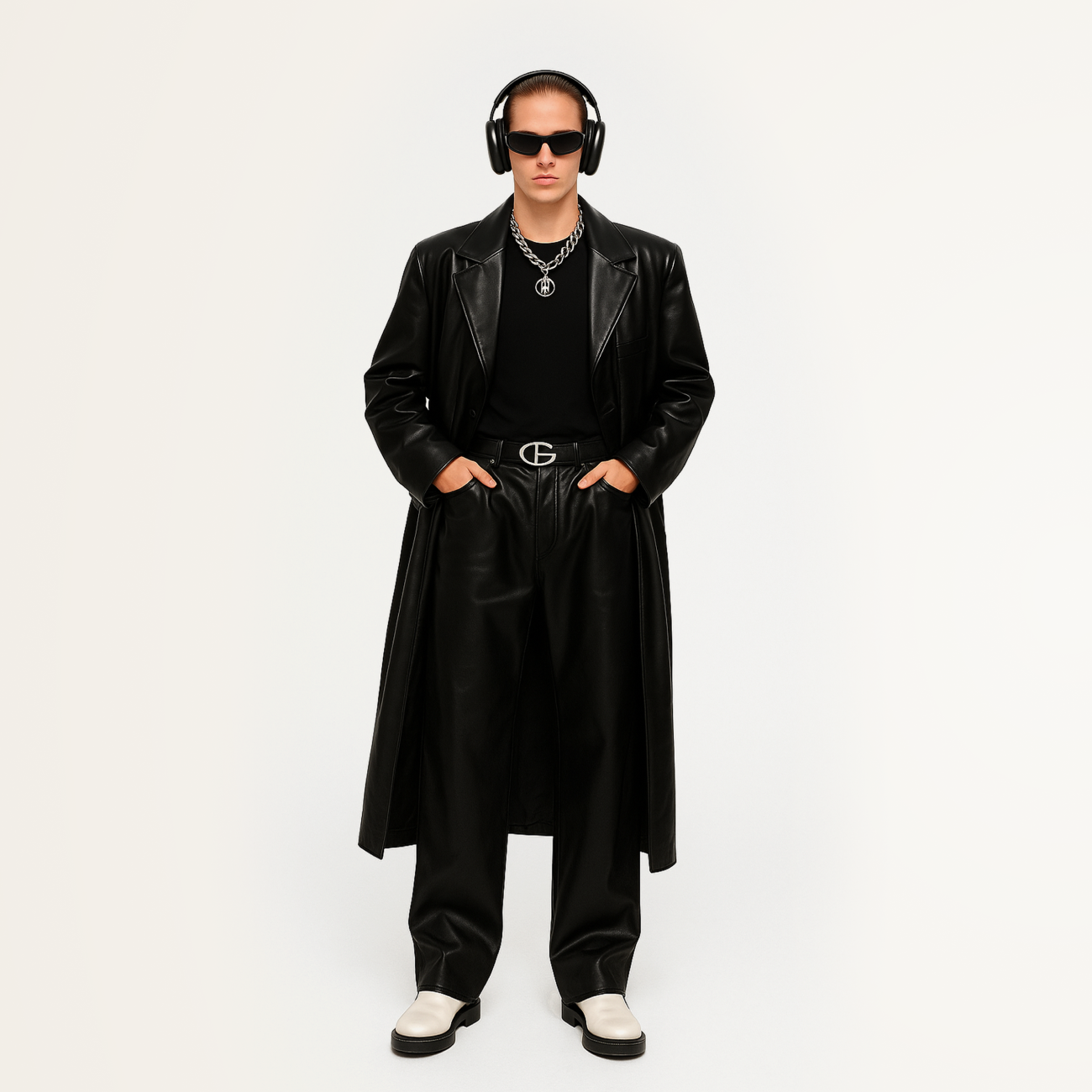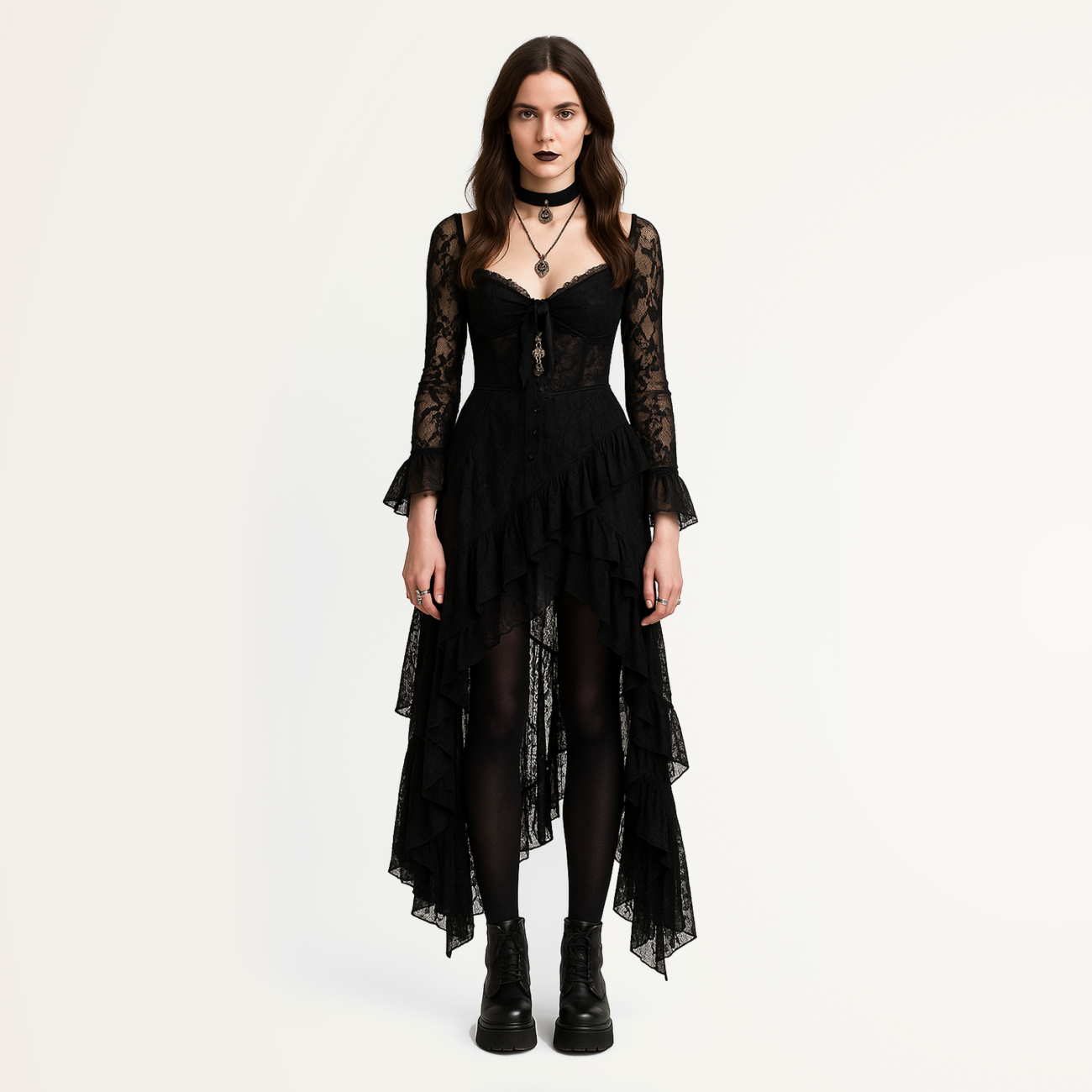Gothic
Gothic style is more than just clothing—it's a form of self-expression deeply connected to philosophical reflections on life and death, the search for meaning, and an exploration of the spiritual and mystical sides of existence. Drawing inspiration from symbolism, romanticism, and the imagery of dark aesthetics, it reveals a profound emotional and intellectual depth.
This style rejects superficiality, embracing the enigmatic beauty found in shadows and contrasts. It speaks to eternal themes, expressing them through sharp lines, rich, saturated colors, and an atmosphere that is both melancholic and mesmerizing. Gothic fashion becomes a visual language for introspection, mystery, and timeless elegance.
History
The history of Gothic style is a centuries-long evolution of cultural symbolism and aesthetics, rooted in the depths of the Middle Ages and continuously transformed by changing eras, worldviews, and ideologies.
Gothic as an aesthetic movement originated in 12th-century European architecture, emerging as a response to the more grounded Romanesque style. The first Gothic cathedrals, built in France, were marked by pointed arches, stained glass windows, soaring spires, and upward-reaching details. This verticality and grandeur reflected the era’s spiritual aspirations and philosophical ideas, with architecture becoming a physical manifestation of divine mystery and eternal longing. As Gothic architecture spread across Europe, it laid the visual and symbolic foundation for what would later become the broader Gothic aesthetic.
Interest in Gothic aesthetics was revived in the late 18th century during the rise of Romanticism, a cultural and philosophical movement that emphasized emotion, mystery, nature, and a fascination with the medieval past. Literature played a key role in this Gothic revival, with authors like Horace Walpole and Mary Shelley pioneering the Gothic novel—a genre filled with ruined castles, ghosts, psychological terror, and dark beauty. This period redefined Gothic as a form of emotional and artistic rebellion against the rationalism of the Enlightenment.
During the Victorian era (1837–1901), Gothic style flourished as a dominant cultural expression, combining austerity with luxury. In fashion, it took the form of long skirts, corsets, lace, and elaborate detailing, often in dark, opulent fabrics. Mourning jewelry made from black jet, cross pendants, and cameos featuring skulls or spiritual motifs became fashionable. The aesthetic extended to interiors, with dark wood carvings, velvet wallpapers, and somber color schemes creating an air of mystery and refinement. It was during this era that Gothic developed many of the visual codes and symbols that continue to define the style today.
A major transformation came in the 20th century, when Gothic evolved beyond historical references to become a subcultural and countercultural movement. In the 1980s, the Goth subculture emerged in the UK, deeply rooted in music and visual art. Bands like The Cure, Siouxsie and the Banshees, and Bauhaus became icons of Gothic expression, combining melancholy romanticism with a bold rejection of societal norms. Their music, lyrics, and aesthetics spoke to a generation seeking identity, freedom, and emotional depth.
During this time, Gothic style solidified its modern visual language: black clothing, lace, leather, heavy boots, chains, and religious iconography like crosses and rosaries. It became a form of resistance to mass culture, transforming from a historical aesthetic into a lifestyle and philosophy. The look was paired with a mindset of introspection, alienation, and search for meaning, distinguishing Gothic as one of the most philosophically charged subcultures.
By the late 20th century, Gothic fashion began influencing high fashion, with designers like Jean Paul Gaultier, Alexander McQueen, and Rick Owens incorporating Gothic themes into their runway collections. These designers elevated Gothic style to the realm of haute couture, reimagining it as elegant, dramatic, and culturally rich. Gothic became hybrid—merging with grunge, punk, and historical elements, evolving into a powerful symbol of mystery, artistry, and intellectual depth.
In the 21st century, Gothic continues to transform, reflecting the diversity and fluidity of modern identity. Numerous substyles have emerged—such as cybergoth, romantic goth, and pastel goth—each offering a unique way to reinterpret the dark aesthetic. Despite its somber tone, Gothic remains relevant and empowering, serving as a means of personal expression, a critique of conformity, and a celebration of inner strength and philosophical exploration.
Signature elements of the style
Color palette
The foundational color of Gothic style is black, symbolizing mystery, introspection, and the unknown. It is often enriched with deep burgundy, rich violet, emerald green, and dark navy blue. Metallic accents like silver and bronze are occasionally added to emphasize the dramatic and ornate nature of the look
Prints
Prints are used sparingly in Gothic fashion. When present, they typically appear as intricate lace-like patterns, vintage florals, chains, or cross motifs. These are often subtle and incorporated through embroidery, texture, or fabric reliefs, contributing to the overall sense of depth and mystery.
Textures
Gothic style favors luxurious, tactile fabrics such as velvet, brocade, lace, leather, chiffon, satin, and suede. These materials bring a sense of aristocratic refinement and moody elegance, enhancing the silhouette and evoking a sense of romantic darkness.
Cuts & silhouette
Gothic garments are often characterized by elongated, structured lines, with a strong architectural framework. Expect long silhouettes, asymmetry, and frequent use of corsets and fitted shapes that highlight the curves of the body. Key features include drapery, floor-length skirts, dramatic sleeves, and emphasized shoulders. The style draws heavily from historical references, especially the silhouettes of Victorian England and the Medieval era, giving it a timeless and theatrical presence.
Wardrobe essentials
- Dresses and skirts: Long and flowing, often made of velvet or lace, featuring asymmetrical cuts, high necklines, or Victorian-inspired collars that draw attention to the neck and silhouette.
- Corsets: A signature piece of Gothic fashion, corsets add feminine structure, emphasizing the waist and creating a striking, sculpted form.
- Capes and coats: Typically long and dramatic, with loose cuts, hoods, or stand-up collars, these outer layers evoke a sense of mystery and medieval romance.
- Lace and ruffles: Used as ornamental elements on blouses, dresses, and collars, they bring a touch of romanticism and textural contrast to the overall look.
- High boots and lace-up ankle boots: Footwear is often structured and statement-making, with lacing, chunky soles, or Victorian-inspired detailing, reinforcing the grounded, dramatic character of Gothic style.
Substyles
- Victorian Gothic: A classic interpretation inspired by the era of Queen Victoria, featuring lace collars, corsets, and long, structured dresses. It emphasizes elegance, historical silhouettes, and a somber, romantic sensibility.
- Romantic Gothic: A softer, more feminine take on the style, heavily influenced by poetry and literature, such as the works of Lord Byron. It leans into lace, chiffon, and abundant accessories, creating an ethereal and melancholic atmosphere.
- Punk Gothic: A bolder, more rebellious fusion of Gothic and punk aesthetics. Expect to see leather, studs, chains, and an emphasis on layering and attitude—a look that challenges norms while retaining dark romantic undertones.
- Cyber Gothic: A futuristic blend of Gothic with post-apocalyptic and industrial influences. Characterized by metallic and plastic elements, chunky boots, and futuristic accessories, this substyle explores dystopian visions while maintaining Gothic darkness at its core.
Email: support@belt-app.com


















